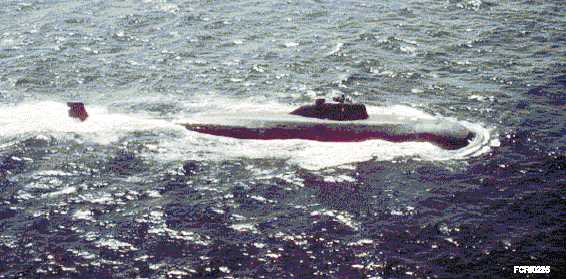the maximum range at which they can reliably detect a
target and their ability to distinguish individual targets
in a multi-target group. In addition, sensor subsystems
must be able to detect targets in a medium cluttered
with noise, which is any energy sensed other than that
attributed to a target. Such noise or clutter is always
present in the environment due to reflections from rain
or the earth’s surface or because of deliberate radio
interference or jamming. It is also generated within the
electronic circuitry of the detecting device.
Tracking the Target
Sensing the presence of a target is an essential first
step to the solution of the fire control problem. To
successfully engage the target and solve the problem,
updates of the target’s position and velocity relative to
the weapon system must be continually estimated.
This information is used to both evaluate the threat
represented by the target and to predict the target’s
future position and a weapon intercept point so the
weapon can be accurately aimed and controlled. To
obtain target trajectory information, methods must be
devised to enable the sensor to follow or track the
target. This control or “aiming” may be done by a
collection of motors and position-sensing devices
called a servo system. Inherent in the servo process is a
concept called feedback. In general, feedback provides
the system with the difference between where the
sensor is pointing and where the target is actually
located. This difference is called system error. The
system takes the error and, through a series of
electro-mechanical devices, moves the sensor or
weapon launcher in the proper direction and at a rate
that reduces the error. The goal of any tracking system
is to reduce this error to zero. Realistically this isn’t
possible, so when the error is minimal the sensor is said
to be “on target.” Sensor and launcher positions are
typically determined by devices that are used to
convert mechanical motion to electrical signals.
Synchro transformers and optical encoders are
commonly used in servo systems to detect the position
and to control the movement of power drives and
indicating devices. Power drives move the radar
antennas, directors, gun mounts, and missile
launchers.
The scenario presented in the beginning of this
section was in response to a single target. In reality, this
is rarely the case. The modern “battlefield” is one in
which sensors are detecting numerous contacts,
friendly and hostile, and information is continually
being gathered on all of them. The extremely high
speed, precision, and flexibility of modern computers
enable the weapons systems and their operators to
compile, coordinate, and evaluate the data, and then
initiate an appropriate response. Special-purpose and
general-purpose computers enable a weapons system
t o d e t e c t , t r a c k , a n d p r e d i c t t a r g e t m o t i o n
automatically. These establish the target’s presence
and define how, when, and with what weapon the target
will be engaged.
Engaging the Target
Effective engagement and neutralization of the
target requires that a destructive mechanism, in this
case a warhead, be delivered to the vicinity of the target
(see figure 2-24). How close to the target a warhead
must be delivered depends on the type of warhead and
the type of target. In delivering the warhead, the
2-19
Figure 2-25. —Enemy submarine.


